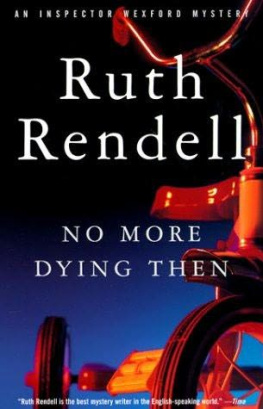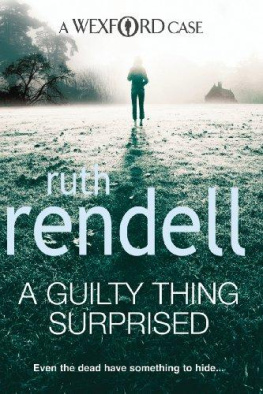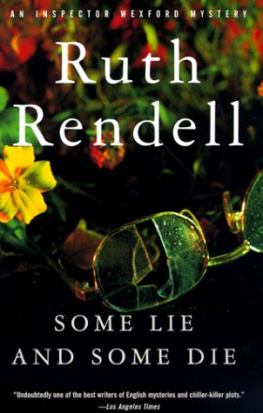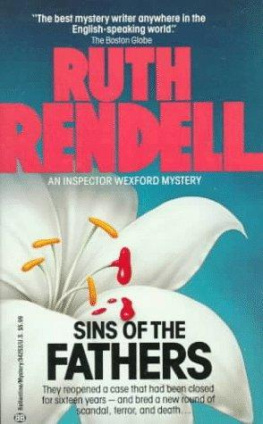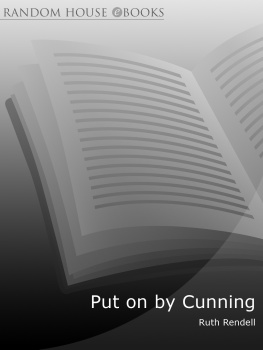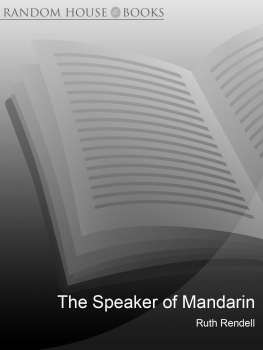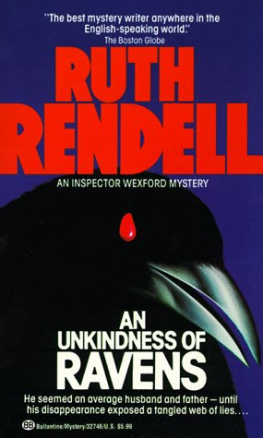Ruth Rendell - Veiled One
Here you can read online Ruth Rendell - Veiled One full text of the book (entire story) in english for free. Download pdf and epub, get meaning, cover and reviews about this ebook. year: 1989, publisher: Fawcett, genre: Art / Detective and thriller. Description of the work, (preface) as well as reviews are available. Best literature library LitArk.com created for fans of good reading and offers a wide selection of genres:
Romance novel
Science fiction
Adventure
Detective
Science
History
Home and family
Prose
Art
Politics
Computer
Non-fiction
Religion
Business
Children
Humor
Choose a favorite category and find really read worthwhile books. Enjoy immersion in the world of imagination, feel the emotions of the characters or learn something new for yourself, make an fascinating discovery.

- Book:Veiled One
- Author:
- Publisher:Fawcett
- Genre:
- Year:1989
- Rating:4 / 5
- Favourites:Add to favourites
- Your mark:
- 80
- 1
- 2
- 3
- 4
- 5
Veiled One: summary, description and annotation
We offer to read an annotation, description, summary or preface (depends on what the author of the book "Veiled One" wrote himself). If you haven't found the necessary information about the book — write in the comments, we will try to find it.
Veiled One — read online for free the complete book (whole text) full work
Below is the text of the book, divided by pages. System saving the place of the last page read, allows you to conveniently read the book "Veiled One" online for free, without having to search again every time where you left off. Put a bookmark, and you can go to the page where you finished reading at any time.
Font size:
Interval:
Bookmark:
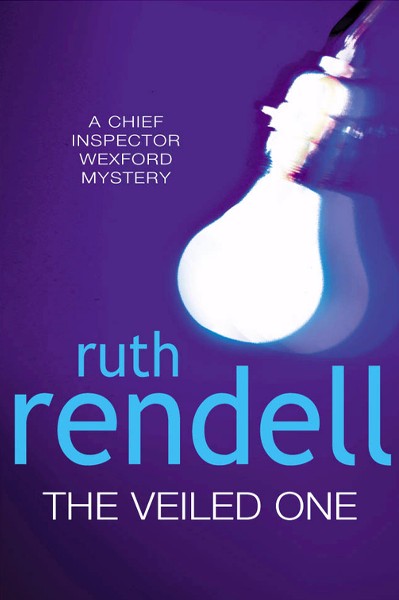
The woman was lying dead on the floor when he came in. She was already dead and covered up from head to toe but Wexford only knew that afterwards, not at the time. He looked back and realized the chances he had missed but it was useless doing that - he hadnt known and that was all. He had been preoccupied, thinking of an assortment of things: his wifes birthday present that was in the bag he carried, modern architecture, yesterdays gale which had blown down his garden fence, this car park that he was entering from the descending lift.
Even the lift was not as other lifts elsewhere, being of rattling grey metal undecorated except for graffiti. Irregular printing from whose letters the red paint had dripped like trails of blood, informed him that someone called Steph was a diesel dyke. He wondered what that meant, wondered too where he could look it up. The lift was going down. Into the bowels of the earth, he thought, and there was something intestine-like about this place with its winding passages and its strictly one-way direction. Perhaps, though, it was better to excavate for this purpose than to erect above the ground, especially as any extraneous building would inevitably have been in the style of the shopping centre itself - ramparts, perhaps, or the walls of a city, some quaint attempt at a reconstruction of the Middle Ages.
He had just come from the Barringdean Centre, the new shopping complex built to look like a castle. That was the style modern planners thought suitable on the outskirts of an ancient Sussex town where nothing genuinely medieval remained. Perhaps that was why. Anyway the centre looked less like a real castle than a toy one, the kind you have to assemble from a hundred plastic bits and pieces. Shaped like a capital I, it had four towers on the ends and a row of turrets along its length. Looking back at it, he half-expected bowmen to appear in the Gothic windows and arrows to fly.
But inside all was of the late twentieth century, only to be expressed in eighties words - amenities, facilities, enclaves and approaches. A great fountain played in the central con course, its waterspouts almost reaching but not quite touching the pendent chandelier of shards of frosted glass. Wexford had entered at this point by the automatic doors and approach from the glass covered way. He had gone up the escalator where a breath of spray stung his fingers on the hand-rail, realized at the top that the shop he sought must be downstairs after all - was not Suzanne the hairdresser who also sold wigs and leotards, or Linen That Shows or Laceworks - and went down again by the escalator to the Mandala. This was a set-piece in the area at the other end with potted plants in concentric circles - brown chrysanthemums, yellow chrysanthemums, white poinsettias and those plants with cherry-like orange fruit that are really a kind of potato. The crowds were thinning out; it was getting on for six when the centre closed up. Shop assistants were weary and growing impatient and even the flowers looked tired.
A Tesco superstore filled the whole crosspiece of the I on both floors at this end, British Home Stores the other. Between them was Boots the Chemist with W. H. Smith facing it, the Mandala in between. Down a side passage that led from the main above-ground car park, children still played on a fat zebra made of black and white leather, a hi-tech climbing frame, a dragon on wheels. Wexford found the shop where Dora, a week ago, had pointed out to him in the window a sweater she liked. Addresses it was called, with a chocolate shop next to it and a wool and craft place Knits n Kits on the other side. Wexford was not a man to hesitate or deliberate over a matter like this. Besides, Demeter the health-food shop opposite was already closing and the jewellers next to it were lowering the fancy gilt latticework bars inside the window. He went into Addresses and bought the sweater, the transaction taking four minutes.
By now shoppers were being hustled out, even Grub n Grains the caf having someone suspiciously like a bouncer on its door. And the lights were dimming, the leaping spouts of the fountain slowing... subsiding, until the ruffled surface of the pool into which it played became glasslike. Wexford sat down on one of the wrought-iron benches that were ranged along the aisle. He let the crowd make its way out through the various arteries that led from this central column and then he too left by the automatic doors into the covered way.
A great exodus of cars from the above-ground car parks was under way. At the far end he looked back. Flags flew from all the turrets along the centres spine, red and yellow triangular pennants which had fluttered all day in the tail-end of the gale but drooped now in the stillness of a dark, misty evening. Slits of light still showed in the narrow pointed-topped Gothic windows. Wexford found himself alone here at the entrance to the underground car park, the only evidence of those hordes of shoppers being their abandoned trolleys. Hundreds of these jostled each other in higgledy piggledy fashion, and would no doubt remain here till morning. A notice informed their users that the police took a serious view of those who allowed a shopping trolley to obstruct the roadway. Not for the first time, Wexford reflected that the police had more important things to do - though how much more important he was only to realize later.
The planners had decreed that this car park must be subterranean. He came into the lift and the stairs by way of a metal door whose clanging reverberations could still be heard as the lift descended. Wexford heard its echoes and at the same time feet pounding up the stairs, the feet of someone running hard; that was something else he remembered later. Down here it was always cold, always imbued with an acrid chemical smell as of metal filings awash in oil. Wexford stepped out of the lift at the second of four levels and came into the wide aisle between the avenue of pillars. Most of the cars were gone by now and in their absence the place seemed more desolate, uglier, more of a denial. Of course it was foolish and fanciful to think like this - a denial of what, for instance? The car park merely served a purpose, filled a need in the most practical utilitarian way. What would he have had instead? White paint? Murals? Tiles on the wall depicting some episode of local history? That would have been almost worse. It was irrational that the place reminded him of a picture it did not in the least resemble - John Martins illustration of Pandemonium for Paradise Lost.
His car was parked at this end. He didnt have to walk the length of the place - under the low concrete ceiling, between the squat uprights, into the wells of shadow - but merely cross over the bays along the left-hand wall. There was an echo down here and the sound of his footsteps rang back at him. If his powers of observation, in general so sharp, were less acute than usual, at least he noticed the numbers of cars that remained and their makes and colours. He saw the three between him and the middle of the car park where one ramp came up and another went down: one on the left, a red Metro, and diagonally opposite it on the right, parked side by side, a silver Escort and a dark blue Lancia. The womans body lay between these two, closer to the Escort, concealed by a shroud of dirty brown velvet which made it look like a heap of rags.
Or so they told him afterwards. At the time he saw only the cars, the colours of their bodywork not entirely drained by the cold strip lights but muted, made pale. He lifted the boot-lid and put inside it the dark blue bag with Addresses stamped on it in gold. As he closed it a car went by him, a red car going rather too fast. There were more red cars than any other colour, he had read somewhere. Motorists are aggressive and red is the colour of aggression. He got into the car, started it and looked at the clock. This was something he always did quite naturally, looked at the clock when he started the ignition. Seven minutes past six. He put the automatic shift into drive and began the climb out of the earths bowels.
Next pageFont size:
Interval:
Bookmark:
Similar books «Veiled One»
Look at similar books to Veiled One. We have selected literature similar in name and meaning in the hope of providing readers with more options to find new, interesting, not yet read works.
Discussion, reviews of the book Veiled One and just readers' own opinions. Leave your comments, write what you think about the work, its meaning or the main characters. Specify what exactly you liked and what you didn't like, and why you think so.

